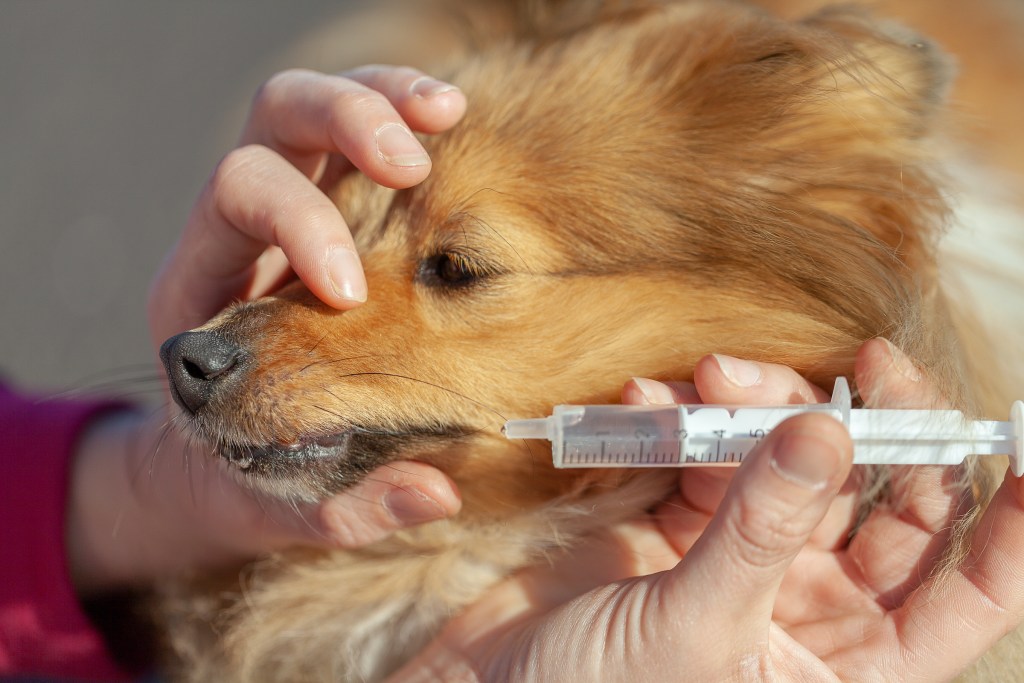It can be terrifying to find out your dog swallowed something they shouldn’t have — whether they got into the Halloween candy or scarfed down something inedible — but learning how to make a dog throw up can turn a scary situation into a close call. First things first, you should always reach out to your veterinarian if you suspect your pup ingested a foreign object. Then, you can take advantage of one of these at-home techniques for inducing vomiting if your vet gives you the go-ahead.
Learning how to make a dog throw up shouldn’t be taken lightly, even if you feel confident you know what you’re doing. Swallowing foreign objects can lead to many complications, so you want to make sure you won’t make the situation worse. This is another reason your vet should be your first phone call. Here's how to make a dog throw up — safely and at home.

How to make a dog throw up after swallowing a foreign object
Surprisingly, the most commonly used emetic for canines is something you likely already have at home: hydrogen peroxide 3% solution. This liquid, which is usually used to clean people’s wounds (don’t use it to clean cuts and scrapes on pets, please), works as an irritant to your dog’s stomach, which results in vomiting.
Step 1: Please try this only after consulting with your veterinarian, or — even better — while they are on the phone or in contact with you.
Step 2: The American Kennel Club (AKC) lists the proper dosage of peroxide as follows: 1 teaspoon per 5 pounds of body weight (a graduated syringe will help with this). No matter your dog’s weight, though, the dose should never exceed 3 tablespoons (there are 3 teaspoons in 1 tablespoon).
Step 3: Your vet may give permission to administer a second dose if your dog doesn’t start vomiting within 15 minutes, but be sure to ask before giving any more.
Step 4: Stay with your dog until you can get them to a vet. You’ll need to keep an eye out for complications of vomiting, such as diarrhea, dehydration, bloat, or lethargy.
Step 5: You can also try helping your dog vomit on their own by feeding them a small meal after swallowing a foreign object. This works best if they haven’t eaten at all in 2 or more hours, though, and this can be less invasive than using peroxide.

How long will it take to make a dog throw up when you give them hydrogen peroxide?
According to the canine health professionals with the AKC, 3% hydrogen peroxide helps a dog vomit within about 10 to 15 minutes. Here’s the catch: The vomiting that results from this can last for over 45 minutes. While this is happening, keep your pup calm and comfortable, watching for signs of distress. Hydrogen peroxide usually helps a dog throw up about half of their stomach contents, so you need to continue gentle care for a while after they vomit. Ideally, using this at-home method buys you enough time to bring your dog to a vet’s office.

Can hydrogen peroxide hurt a dog when used to induce vomiting?
Although peroxide is an approved emetic for canines, it can still be dangerous when consumed incorrectly or in excess. It’s important to use 3% hydrogen peroxide to avoid complications, such as ulcers, loss of appetite, and damage to the stomach and intestinal lining.
In exceptionally rare cases, even if used correctly, peroxide can cause a type of brain inflammation that produces loss of motor control and even collapse. This is another reason why it’s important to stay by your pet’s side if you do administer hydrogen peroxide in any amount. Even better, be on the phone with a veterinary professional, too.

When not to make a dog throw up (Hint: Always ask your vet)
There are many situations when inducing vomiting may put your dog in more danger than they were in before. For example, any dog who is already throwing up should not be administered peroxide. Some breeds, particularly brachycephalic kinds who have squished-looking faces (think breeds like French bulldogs and pugs), have a greater risk of aspiration pneumonia than other pups, so they would be safer vomiting while under veterinary care, according to the AKC.
Whether to induce throwing up also depends on what your dog ingested. If they swallowed some kind of chemical or medication, vomiting could cause severe harm. The same can be said for sharp or textured objects, as stomach or throat obstruction can be fatal. In addition, it isn’t recommended to force your pet to vomit if they have the following conditions or symptoms:
- Serious lethargy
- Decreased ability to swallow
- Issues with breathing
- Hyperactivity
- Seizures
- Recent abdominal surgery
- General enlargement of the esophagus
- Comatose

When to make a dog throw up
We can't stress this point enough: This question should be answered in conjunction with a vet because of all the risks mentioned above. However, there may be times when your pup's vet suggests trying to induce vomiting at home. These reasons may include:
- Your dog ingested something potentially toxic
- The consumption was recent (within the hour)
- Your dog is not showing symptoms of being poisoned, such as vomiting or lethargy
- Your dog does not have underlying medical conditions
- Your dog is not a brachycephalic breed
If you cannot get through to your vet, the ASPCA has a poison control hotline that you can call at (888) 426-4435. A person will walk you through the pros and cons of making your pet vomit or you should seek emergency care for your furry friend.

Can salt water make a dog throw up?
Hydrogen peroxide is not the same thing as salt water — don't get these two confused as the results can have deadly consequences. Salt water is more likely to cause diarrhea, which won't solve the problem if your pup just swallowed an entire chocolate bar. Additionally, excessive salt water intake could result in dehydration and turn fatal. Ensure you have the correct chemical before giving it to your dog. Lastly, hydrogen peroxide can turn to water if stored incorrectly, so check that yours has been well sealed in a dark bottle before administering (it won't hurt your dog if this reaction has occurred, but will reduce the effectiveness).
Because of all the variables involved in a dire situation like this, it’s important to see why your dog’s veterinarian needs to be a part of the process. Not only are they medical professionals, but they also will be calm and collected in the moment, allowing them to make the most informed decision for your dog. After all, your four-legged friend deserves only the best medical care. As for you — don’t forget to breathe!




